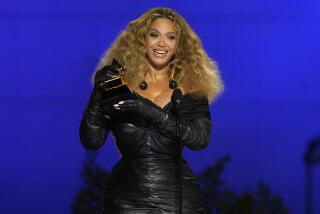Bach for the 1990s, From the 1950s on EMI/Angel
In what amounts to an act of daring these days, EMI/Angel has released a recording of Bach played on modern instruments.
Barbara Hendricks, whose pronounced vibrato wouldnât be at all acceptable in an antiquarian performance, is the featured soloist, applying her agile, exquisitely tuned soprano to two of the composerâs most famous solo cantatas, âJauchzet Gott,â BWV 51, and the âWeddingâ Cantata, BWV 202, as well as to Bachâs own reworking for soprano of âIch habe Genug,â BWV 82, originally for bass (EMI/Angel 49843).
The overall sound of the C.P.E. Bach Chamber Orchestra of Berlin may be on the lush side and Peter Schreierâs conducting occasionally tends toward the heart-on-sleeve. But he keeps things moving for the most part and his instrumental soloists perform with admirable stylistic awareness.
Although listeners may desire a keener rhythmic attack and more of the jubilation inherent in both âJauchzet Gottâ and âWeichet nur,â it is difficult to imagine more accurate and sweet-toned singing than Hendricks offers here, and she does surprisingly well in suggesting the protagonistâs world-weariness in âIch habe Genug.â
EMI/Angel offers strong, simultaneous competition in a âJauchzet Gottâ appearing as part of a collection of recordings originally made by Elisabeth Schwarzkopf between 1947 and 1955 (63201, mid-price). The soprano launches into Bach with an intensity more akin to that of avenging angel than celebrant, but there is immense spirit and point to her singing, and to Peter Gellhornâs conducting of a crack ensemble from the Philharmonia Orchestra.
The two sopranos offer one additional Bach work in common: the familiar âSheep May Safely Grazeâ aria from the secular cantata, BWV 209. Here, Hendricksâ guilelessness, her delightful embellishments and one of the most ethereal trills extant win out handily over Schwarzkopfâs artfulness.
The latterâs program further includes her famous, incomparably vivacious interpretation of Mozartâs âExsultate, jubilate,â and arias by Handel and Beethoven.
Bachâs B-minor Mass as recorded under Herbert von Karajanâs direction in 1952 is in contrast a sluggish, densely textured abomination--even by the standards of its time; a surpassingly well-sung and well-played abomination, however.
The vocal quartet, comprising Schwarzkopf, Marga Hoffgen, Nicolai Gedda and Heinz Rehfuss, has seldom been surpassed on recordings, while the instrumental soloists, again from the Philharmonia Orchestra, and the chorus of the Vienna Gesellschaft der Musikfreunde manage to make their positive presences felt in spite of the conductorial odds against them (EMI/Angel 63505, two midpriced CDs).
A particularly rewarding recent period Bach recording finds Philippe Herreweghe directing the splendid Franco-Belgian forces of La Chappelle Royal and the Collegium Vocale in one of the darkest and grandest of the sacred cantatas, âIch hatte viel Bekummernis,â BWV 21, and the instrumentally brilliant âAm Abend aber desselbigen Sabbats,â BWV 42 (Harmonia Mundi 90328).
Herreweghe leads with an affecting combination of dignity and rhythmic energy, with soprano Barbara Schlick and tenor Howard Crook outstanding among the vocal soloists.
Nor is there any shortage of energy or skill in the Bach program by Londonâs Taverner Players under the direction of Andrew Parrott: the âMagnificatâ; the so-called âAscensionâ Oratorio, BWV 11, and the brief choral cantata, âNun ist das Heil,â BWV 50 (EMI/Angel 49959).
The instrumentalists, including trumpeter Crispian Steele-Perkins and oboist Paul Goodwin, are among the period-performance elite, while the vocal contingent boasts such paragons as Emma Kirkby and Emily van Evera.
But there are irritants too: the excessively clipped phrases and the unvarying flat-white quality of the solo voices, elements that belong to an earlier, more puritanical phase of the antiquarian movement.
What may prove the ultimate sticking point here is the absence of a chorus, i.e., the soloists--ranging en masse from five to eight--fulfill that function as well, in accordance with some controversial recent scholarship. It works in the fast, contrapuntal numbers, particularly in BWV 11.
But when the text calls for thunder and we receive instead neatly traced little vocal patterns, we can only wonder whether Bach really wanted such small forces or whether, as some of his correspondence suggests, he chafed at the necessity of having to make do with them. Bachâs employers were, it should be remembered, anything but generous.
More to Read
The biggest entertainment stories
Get our big stories about Hollywood, film, television, music, arts, culture and more right in your inbox as soon as they publish.
You may occasionally receive promotional content from the Los Angeles Times.










